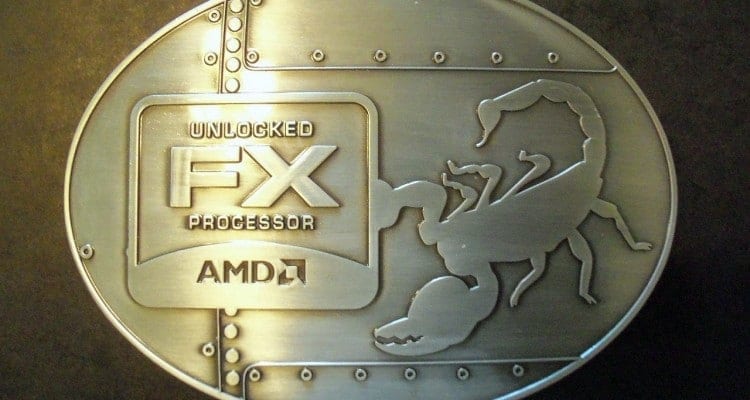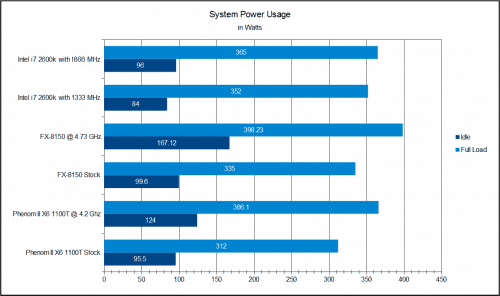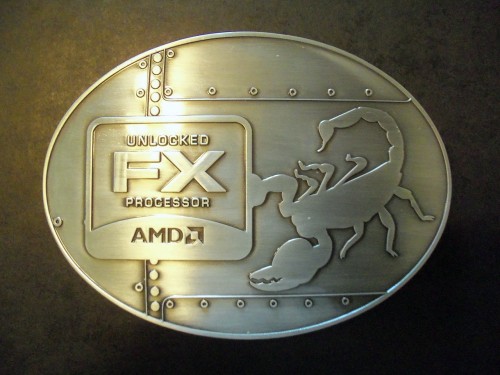Power Consumption
There has been a lot of people claiming the FX-8150 will eat power once overclocked and I am sure it will when you set all the voltages to what AMD stated as their maximums. Any system with voltage numbers set to maximum for all options will burn a lot of power and it will not just be the CPU causing the increase.
I do not have the restrictively expensive equipment I would need to test just the CPU’s power use, so these figures only apply to me and my particular system. As you can see the power figures fall right in line. The FX-8150 has 2 additional Integer cores and thus uses more power at both idle and load. The Intel system has a more power hungry GPU and thus uses more power at load. Nothing here was really out of the ordinary to me.
There is a wall at around 4.8 GHz for the FX-8150 and getting over it will take a lot more power than I was willing to give my system. While it did not work for long, the 5.2 GHz stress test seemed to show power use well into the mid 400 watt range. I would image getting it to be stable at that speed would require even more power than I was giving my system at the time.
Final Thoughts
There has been a lot of talk on the Internet about lack luster performance and disappointed reviewers of the Bulldozer processor. I am personally not disappointed, but I am not impressed either. The “FX” moniker stood for the top performing chip of its time no matter how you sliced it. Bulldozer is a brilliant, forward looking design, but it does not deserve the “FX” title.
The issue with the Bulldozer design is it seems to have something personal against old software. Since many of the programs used for testing attempt to keep the scales even across several generations, testing programs inherently have to use older software designs. Simple put, Bulldozer does not benchmark well, but does well in real world scenarios.
I cannot conclusively say why the FX chips struggle with single threaded applications. I can say it only applies to single threads that repeat a single task constantly such as cryptography, video encoding, Folding@Home, etc. And even then it only struggles when the program is either really old or using old instruction sets. When the process is a task that works in blocks, such as video streaming, web browsing, file scanning, etc. there is no issue. In either case, it is clear the FX-8150 will easily out perform the 1100T when newer compiled code uses the newest instruction sets such as AES and SSE4.2.
I have used the FX-8150 for well over a week as my daily system and I have not once thought it was slow. The software I know it lacks performance in are trivial programs such as web browsers, temporary file cleaners, multimedia players, and old games. These programs are simply not CPU intensive enough to have noticeable performance loss. On the other side of the spectrum, the software I use that does require a lot of CPU horsepower, the FX-8150 excels in such as 7-Zip, Battlefield 3 (we’ll revisit this in an upcoming article), virus scanning, and video encoding.
Then you have games built for two and four core systems in mind where performance is no different than the Phenom II.
The performance, when measured, is a roller coaster ride of massive rises, dips, and turns. It is that very lack of clear improvement across the board that is making people scratch their heads. I agree with them wholeheartedly that the Bulldozer Tunnel Vision looks bad when tested. No one should need to find the right software to properly utilize a Bulldozer processor, or count on future software updates to give them better results.
In the end, the FX-8150 can be found at $279.99 between the i7 2500k and i7 2600k. It is priced exactly where it should be considering its general performance. Though I can’t recommend the Scorpius platform for everyone, those that do invest in it will not be disappointed in its overall performance. It should be a great upgrade for those using Phenom II X4s or for anyone looking to build a reasonably priced gaming system today. Everyone else should just wait to see what the future holds as FX chips seem to be doing the same thing too.
Pros
- New Instruction Sets
- Great Multimedia and Computational Performance
- Improved Memory Controller
- SLI Support
- Consistent Features Across all 900 Series Motherboards
Cons
- Weak Single Thread Performance
- Inconsistent Multi-Threaded Performance
- Overall Performance does not Warrant “FX” title
- Some 800 Series AM3+ Motherboards will still Need BIOS Update to Support FX chips
Overall Rating: 7.0 / 10.0
Help Us Improve Our Reviews By Leaving a Comment Below!



